

High Speed Black 64 Circuits Straight Dip Type PCIE Connector With Post card edge connector
- Part No : PCIEV10-64-PG card edge connector
-
1. Current Rating : 3.0Amps
2. Voltage Rating : 250V AC
3. Contact Resistance : 30m Ohm Max At DC 100m Amps
4. Insulation Resistance : 100M Ohm Min at DC 500V
5. Withstanding Voltage : 1 Minute At 750V r.m.s Min
6. Operating Temperature Range : -40°C ~ 85°C
Meterials:
1.Insulator:High Temp. Plastic (Nylon 46 UL94V-0)
Color :Black
2.Terminal: Copper Alloy
3.Plating: Tin Plated - Inquiry now
- Products Drawing
Detailed description
Discover dependable PCI connectors for seamless data connectivity.
Discover our selection of dependable PCI connectors, engineered to provide seamless and high-speed data connections. Whether you’re working on consumer electronics, industrial equipment, or other electronic projects, our connectors are designed to meet your connectivity needs.
Key Features:
- Reliable Performance: Our PCI connectors are built to deliver consistent and reliable data connections, ensuring the smooth operation of your devices.
- High-Speed Data Transfer: Designed for high-speed data transfer, these connectors are ideal for applications where data speed is crucial.
- Versatility: Our connectors are versatile and suitable for a wide range of applications, making them a valuable addition to your electronic projects.
- Precision Engineering: Crafted with precision engineering, these connectors meet industry standards for quality and performance.
Why Choose Us?
- Quality Assurance: Our connectors are manufactured to the highest quality standards, ensuring long-lasting performance.
- Expert Support: Our team of experts is available to assist you with technical questions or provide guidance for your specific project requirements.
- Fast Delivery: We offer prompt and reliable shipping to get the connectors you need delivered to your doorstep.
Conclusion:
For seamless and dependable data connectivity, trust our PCI connectors to keep your electronic projects running smoothly. With a focus on quality, performance, and versatility, our connectors are the ideal choice for your connectivity needs.
Email: sales09@dghoyato.com
Skype:sales09@dghoyato.com
PCIe and Card Edge Connectors: A Deep Dive into Modern High-Speed Interconnects
Introduction
Peripheral Component Interconnect Express (PCIe) is a high-speed interface standard commonly used for connecting various hardware components within a computer, such as graphics cards, SSDs, and network cards, to the motherboard. At the heart of the PCIe interface is the card edge connector, a crucial component that facilitates the physical and electrical connection between the PCIe card and the motherboard. This article delves into the intricate relationship between PCIe and card edge connectors, exploring their roles, design, and importance in modern computing.
The Evolution of PCIe
From PCI to PCIe
The evolution of interconnect standards in computing has been marked by the transition from Peripheral Component Interconnect (PCI) to PCIe. Introduced in the 1990s, PCI was a popular standard that allowed for the connection of various hardware components. However, as computing demands grew, especially in terms of data transfer speeds and bandwidth, PCI became increasingly inadequate. This led to the development of PCIe, which offered significant improvements in terms of speed, scalability, and flexibility.
PCIe Generations
PCIe has undergone several iterations, each offering enhancements over its predecessors. The first generation of PCIe, introduced in 2003, offered a data transfer rate of 2.5 GT/s (Giga-transfers per second) per lane. Subsequent generations have progressively increased these speeds, with PCIe 4.0 offering 16 GT/s per lane and PCIe 5.0 doubling that to 32 GT/s per lane. PCIe 6.0, expected to be released soon, promises even higher speeds, marking a significant leap in performance.
Understanding Card Edge Connectors
What is a Card Edge Connector?
A card edge connector is a type of connector that allows the insertion of a printed circuit board (PCB) edge into a corresponding slot on another PCB, such as a motherboard. The edge of the card, usually plated with conductive materials like gold, has a series of contact pads that align with the contacts in the connector slot. This design provides a simple yet effective method for establishing electrical connections between the card and the motherboard.
Design and Construction
The design of a card edge connector is critical to its performance. Typically, these connectors are made from high-quality materials to ensure durability and reliable electrical connections. The contacts are often gold-plated to prevent corrosion and reduce resistance, which is crucial for maintaining high-speed data transfer rates. The connectors are also designed to provide a secure mechanical connection, ensuring that the card remains firmly in place even under vibration or movement.
Types of Card Edge Connectors
Card edge connectors come in various types, each tailored for specific applications. In the context of PCIe, the most common types are:
– **Straight Edge Connectors:** These connectors allow for the insertion of the card in a straight, vertical orientation relative to the motherboard. They are commonly used in desktops and workstations.
– **Right-Angle Edge Connectors:** These connectors allow the card to be inserted at a right angle to the motherboard, which can be beneficial in space-constrained environments like small form factor (SFF) PCs.
The Role of Card Edge Connectors in PCIe
Signal Integrity
One of the most critical aspects of card edge connectors in PCIe applications is maintaining signal integrity. As data transfer rates increase with each PCIe generation, the risk of signal degradation becomes more significant. High-quality card edge connectors are designed to minimize impedance, crosstalk, and other factors that could negatively impact signal integrity. This ensures that data is transmitted accurately and at the maximum possible speed.
Power Delivery
In addition to data transmission, card edge connectors in PCIe applications are also responsible for power delivery. Depending on the card, significant amounts of power may be required, particularly for high-performance GPUs or other power-hungry components. Card edge connectors must be capable of handling these power requirements without overheating or suffering from power loss.
Mechanical Stability
Mechanical stability is another essential aspect of card edge connectors. PCIe cards, particularly large ones like GPUs, can be heavy and may put a strain on the connector. A well-designed card edge connector provides a secure mechanical connection, preventing the card from dislodging or causing damage to the motherboard.
Challenges in Card Edge Connector Design
High-Speed Data Transmission
As mentioned earlier, the increasing data transfer rates in PCIe present a significant challenge for card edge connector design. Ensuring that the connectors can handle these speeds without signal degradation requires careful design, high-quality materials, and precise manufacturing.
Thermal Management
Another challenge in card edge connector design is thermal management. High-speed data transmission and power delivery generate heat, which can impact the performance and longevity of the connector. Designing connectors that can effectively dissipate heat while maintaining a compact form factor is a complex task.
Compatibility and Standardization
With the rapid evolution of PCIe standards, ensuring compatibility between different generations of PCIe cards and motherboards is crucial. Card edge connectors must be designed to accommodate various PCIe standards, allowing for backward compatibility where possible.
Innovations in Card Edge Connector Technology
Improved Contact Materials
One area of innovation in card edge connectors is the use of advanced materials for the contacts. Newer materials, such as palladium alloys, are being explored to improve conductivity, reduce wear, and enhance corrosion resistance. These materials can extend the lifespan of the connectors and improve performance, particularly in high-speed applications.
Enhanced Mechanical Designs
Innovations in mechanical design are also being pursued to improve the stability and reliability of card edge connectors. For example, some connectors now feature locking mechanisms that provide additional security, preventing the card from being accidentally dislodged. Others use flexible designs that can absorb mechanical stress, reducing the risk of damage to the motherboard or the card itself.
Integration with Advanced Cooling Solutions
As thermal management becomes increasingly critical, some card edge connectors are being designed with integrated cooling solutions. These may include features such as heat sinks or thermal pads that help dissipate heat more effectively. Such innovations are particularly important in high-performance computing environments where overheating can lead to system instability or failure.
The Future of PCIe and Card Edge Connectors
The Impact of PCIe 6.0 and Beyond
With the advent of PCIe 6.0, the demands on card edge connectors are set to increase even further. The higher data transfer rates will require even more robust designs to ensure signal integrity and power delivery. Future connectors may need to incorporate even more advanced materials and manufacturing techniques to meet these demands.
The Role of AI and Machine Learning in Connector Design
Artificial intelligence (AI) and machine learning (ML) are increasingly being used in the design and optimization of electronic components, including card edge connectors. These technologies can analyze vast amounts of data to identify design improvements, predict potential failure points, and optimize manufacturing processes. As a result, future connectors may be more reliable, efficient, and capable of handling the ever-increasing demands of modern computing.
Sustainability Considerations
As with many other areas of technology, sustainability is becoming an increasingly important consideration in the design and manufacturing of card edge connectors. Efforts are being made to reduce the environmental impact of these components through the use of recycled materials, more energy-efficient manufacturing processes, and designs that facilitate easier recycling at the end of the product’s life.
Conclusion
PCIe and card edge connectors are fundamental components of modern computing, enabling the high-speed data transfer and power delivery required by today’s demanding applications. As computing technology continues to evolve, so too will the design and functionality of these connectors. With ongoing innovations in materials, mechanical design, and thermal management, card edge connectors are set to remain a critical element of computing systems for the foreseeable future. The challenges posed by the increasing demands of PCIe standards will continue to drive innovation, ensuring that these connectors can meet the needs of tomorrow’s technology.





